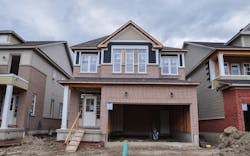Home Builders Alone Can’t Resolve the Nation’s Housing Crisis
After a prolonged period of increases, rent prices experienced their first decline since the onset of the COVID-19 pandemic in May, but despite this temporary relief, the U.S. housing market still faces a significant shortfall of 6.5 million homes, Forbes reports. Data from Freddie Mac reveals that new-home construction isn't keeping pace with household formation, but builders face a series of obstacles to close that gap.
Approximately 61% of Americans report they are unable to afford a home, with one in five individuals believing they may never be able to acquire one, a recent report by A Dime Saved reveals. On the other hand, developers tend to initiate housing projects in more profitable areas where favorable conditions exist and there is high demand for housing, meaning that homes aren’t always being built where they’re most needed. In addition, limited land supply makes it challenging for contractors to find suitable locations for new construction, especially in cities that impose density caps, such as New York's floor-area ratio (FAR) cap, which limits the size of residential buildings in proportion to their lot size.
In June 2023, a senate bill in Florida was signed by Governor Ron DeSantis which provides ample opportunities for developers in the state. The bill invests $711 million for housing projects and programs throughout Florida. It provides multifamily developers and owners with access to property tax exemptions and tax credits.
Incentives like this tend to drive up construction. If developers are able to include tax relief in their business plan, it can spur them on to create housing options for a community’s residents. Thus, local governments that provide tax abatements and incentives could attract a new stream of construction projects.
